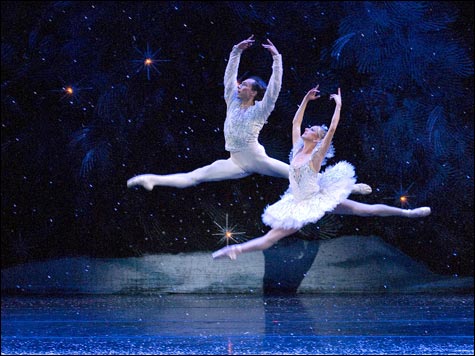
A DRAMATIC LEAP: The Boston Ballet’s decision to leave the Citi Performing Arts Center for the Opera House is headline news within the performing-arts community. |
Media watch
The world of dance criticism has likewise been in turmoil. In February, Boston Herald dance writer Theodore Bale announced he was leaving the paper after it had refused to let him review Alvin Ailey or Bill T. Jones and was hedging on Boston Ballet’s Romeo & Juliet. And this past week, the Village Voice sent Deborah Jowitt, for four decades one of dance writing’s most authoritative voices, packing. The Voice will, it appears, fill her space with freelance copy. Boston Ballet 2008–2009
Boston Ballet has just announced its 2008–2009 season, with The Sleeping Beauty, James Kudelka’s Cinderella, a Jirí Kylián program, a Ballets Russes program, and George Balanchine’s evening-length Jewels — arguably the most important ballet creation of the past 50 years. All productions save for The Nutcracker will be at the Wang Theatre. Here’s the line-up: CINDERELLA [James Kudelka] | October 16–26
THE NUTCRACKER | November 28–December 27
“BLACK AND WHITE”: Jirí Kylián’s Petite Mort, No More Play, Sarabande, Falling Angels, and Six Dances | February 12–15
JEWELS [George Balanchine] | February 26–March 8
THE SLEEPING BEAUTY | April 23–May 3
“DIAGHILEV’S BALLETS RUSSES CENTENNIAL CELEBRATION”: The Prodigal Son [George Balanchine], The Afternoon of a Faun [Vaslav Nijinsky], Le Spectre de la Rose [Michel Fokine], Le Sacre du Printemps [Jorma Elo] | May 14–17 |
It’s been a roller-coaster six weeks at Boston Ballet. Back on Valentine’s Day, as the company opened its production of John Cranko’s Romeo & Juliet, it was also making the decision to downsize. In early March, the Ballet announced that executive director Valerie Wilder would be leaving at the end of the season (“I am exploring a number of exciting opportunities in the nonprofit world”) and that artistic director Mikko Nissinen would serve as interim executive director while the company conducted the search for her replacement. A week later, Boston Ballet confirmed that it would be laying off nine dancers, reducing the troupe from 50 to 41. And this past Thursday, Nissinen revealed that, starting in 2009, the company will leave its home of the past 30 years, the 3600-seat Wang Theatre, for the 2500-seat Opera House. It’s not a short-term move, either: Boston Ballet has signed a 30-year agreement with Live Nation, which owns and operates the Opera House.
The rupture between Boston Ballet and the Citi Performing Arts Center — both nonprofits — opened in 2004, when the Citi Center, which operates both the Wang Theatre and the Shubert Theatre, notified the Ballet that it would not renew its contract for The Nutcracker. The company’s production of the Tchaikovsky holiday classic had been one of the world’s most attended (drawing upward of 140,000 each season) and most lucrative, but it wasn’t enough of a moneymaker for the Citi Center, which replaced it with The Radio City Christmas Spectacular starring the Rockettes in even-numbered years and Irving Berlin’sWhite Christmas in odd. Boston Ballet scrambled to redo The Nutcracker for the 1700-seat Colonial Theatre in 2004; in 2005, the production moved to the Opera House. The rest of the Ballet’s season — five productions filling eight weekends, with 42 performances — remained at the Wang. This year, after that contract expired and negotiations for a new one broke down (the Ballet wanted to move The Nutcracker back to the Wang; Citi declined), Boston Ballet decided to make the Opera House its home for all performances.
Is Boston Ballet — which, despite being a young (40 years) outfit in a smallish town with limited corporate and public support, has become one of America’s top ballet companies — headed down to the minors? Skeptics might point to the Opera House’s smaller capacity, the smaller size of the stage, and the orchestra pit’s unsuitability for anything like an actual orchestra (as opposed to the 17-or-so-member ensembles that accompany touring Annies and My Fair Ladys). But Nissinen is adamant that this is an opportunity for the company to control its future. At 3600 seats, the Wang is bigger than any dance company really needs. The Opera House stage may be smaller than the Wang’s, but it’s as big as the ones other major companies perform on, and Nissinen says there isn’t any large work — like Swan Lake or The Sleeping Beauty — that the Ballet won’t be able to do in the future. As for the orchestra pit, Boston Ballet faced a similar situation at the Wang, where as part of the 1990 renovation the pit was rebuilt with wood instead of concrete and enlarged to make room for as many as 85 musicians. Boston Ballet music director Jonathan McPhee — one of the organization’s prime assets — oversaw that restoration, and he’ll doubtless do the same at the Opera House, where Live Nation has agreed to rebuild the pit. (If the Ballet wants an elevator, and Nissinen says he does, the company will pay for that part of the restoration.)